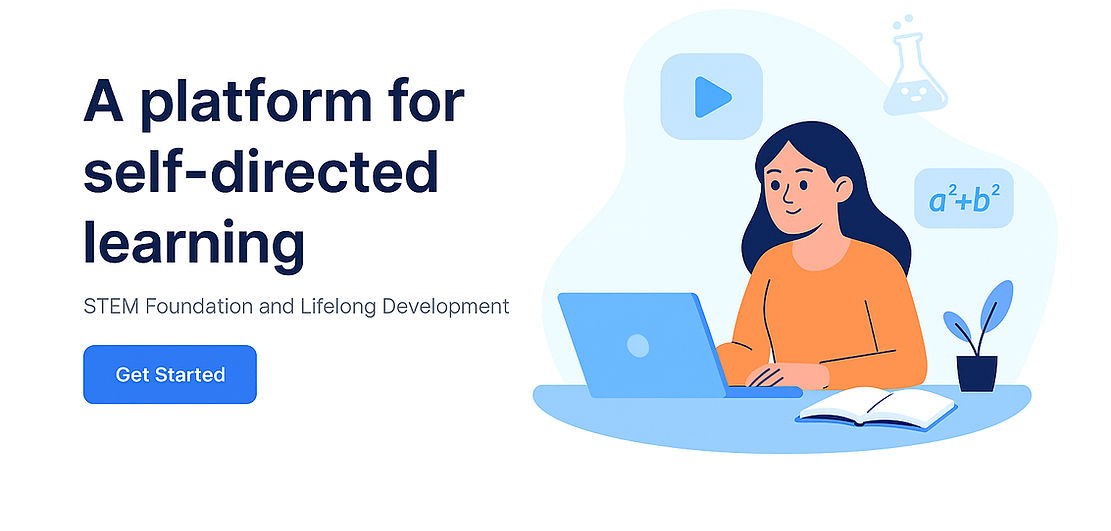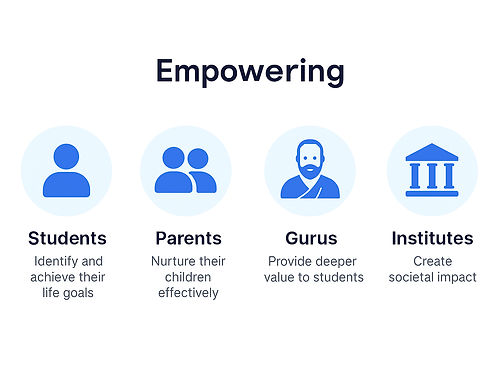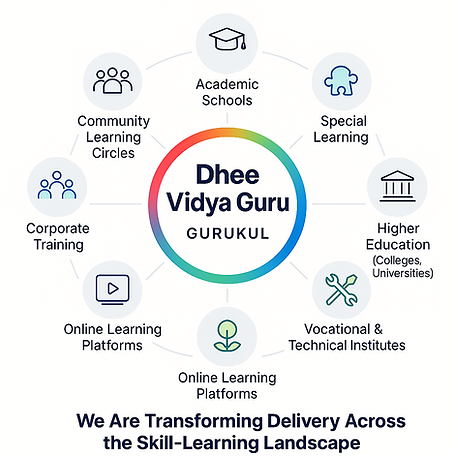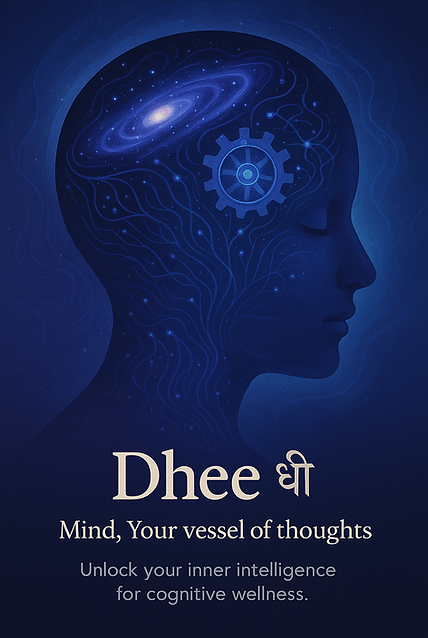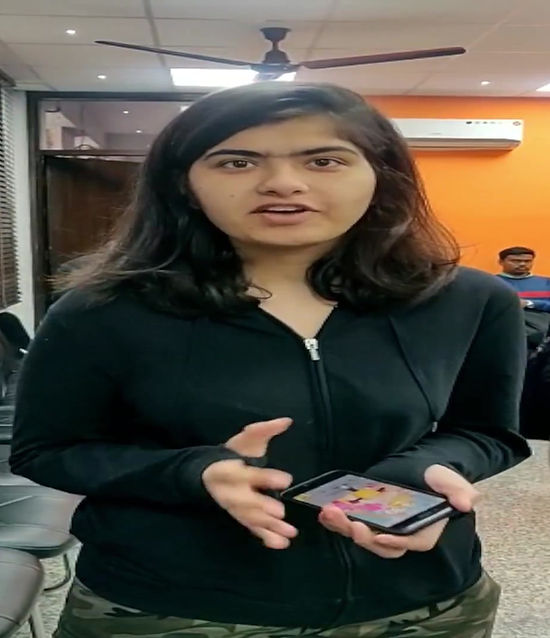- Service Information
30 min
FreeFree
Annual Gurukul Fee
Apply Or Buy Gift Card
Beginner
₹299299₹Valid for 7 daysBasic
₹2,1992,199₹Every year- Best Value
Student Account
₹6,5996,599₹Valid for one year Parent Account
₹11,99911,999₹Valid for one yearGuru Account
₹18,99918,999₹Valid for one yearBusiness Account
₹59,99959,999₹Valid for one yearLearner Forever
₹89,49989,499₹Valid for one year
Autodidacticism or self-education is education without the guidance of masters or institutions. Generally, autodidacts are individuals who choose the subject they will study, their studying material, and the studying rhythm and time.
(STEM) Science, technology, engineering, and mathematics is a broad term used to group together these academic disciplines. This term is typically used to address an education policy or curriculum choices in schools. It has implications for workforce development, national security concerns and immigration policy.
Self-directed learning promotes the natural development of self-confidence, initiative, perseverance and life satisfaction. While we do not ultimately control our lives (due to many outside factors that affect us all, including genes to environmental circumstances), we are each in charge of our own life.
There are many positive effects that result from self-directed learning. Here are a few observations, based on what we saw happening over the last year:
Self-directed learning provides students with the opportunity to teach themselves the most essential skill to become lifelong learners: knowledge of how to learn. Self-directed learning teaches students how to learn, rather than what to learn. If students can learn the ‘how,’ the content or topic can be interchangeable. By allowing this 20% time, school gives them the gift and permission of self-education--which they can grow and nourish the rest of their lives.
Self-directed learning is rooted in the application of skills: thinking skills, research skills, self-management skills, social skills and communication skills. When looking at the list of Dhee Vidhya Guru transdisciplinary skills, it is not uncommon for students to be actively applying more than 75% of the skills throughout any given personalized inquiry. These skills can then be applied to a multitude of different contexts and learning situations, both inside and outside of school.
Self-directed learning gives students further independent practice in comprehension strategies: Students read with a question in mind and activate curiosities along the way; they connect to their background knowledge and schema; they monitor their comprehension when evaluating texts they are interacting with; they determine the important parts of a text to help them focus on specific inquiries; they infer unfamiliar word and concept meaning when reading texts; and, they take everything they have understood and synthesize it into a summary of their new learning.
Self-directed learning increases the amount of time students spend reading and writing. In order to learn more about their curiosities, students must become more proficient in comprehending and creating non-fiction texts and visual modes. As a result, authentic and purposeful literacy development occurs within an inquiry-based setting.
Students are given the freedom to choose the who, the what, the where and the how. They can choose to work independently or with a rotating partner. They can choose to work in the classroom, a quiet room, a shared space or the library. They can choose what they want to learn about and how they want to communicate their new learning. This freedom of choice allows students to find their proximal zone of learning: physically, socially, mentally and emotionally--which promotes metacognitive awareness and self-advocacy along the way.
The degree of independence students exhibit increases exponentially as the year goes along. By the end of the year, the teacher’s primary role is one of connector, enabler and cognitive coach. Student initiation and organizational capacity collectively grows throughout the year. The students know exactly what they are doing and how they want to accomplish it. The teacher's job is to maximize and push the learning potential in each inquiry.
Self-directed learning fosters a collaborative learning environment. Whether students inquire independently or in partnerships, there is a constant cross-pollination of ideas and sharing that takes place. Students engage in negotiation, compromise, feedback and evaluation, especially when learning in partnerships and small groups.
In self-directed learning, the locus of control and influence shifts back to the students. They begin to have greater self-determination and freedom over their learning. As a result, there seems to be a renewed and genuine passion for coming to school and learning. Self-directed learning is students’ favorite time of the day, and many wake up looking forward to this time at school.
Students self-advocate for what they need to learn best. For some students, it might be requesting different spaces and auditory levels to focus. For others, they might advocate for relaxing music, comfortable furniture, technological tools, building or design resources, access to facilities on campus, experts to assist them, etc. Students know that if they ask for something that will help them learn and can justify the request, the answer will almost always be ‘yes.' This has allowed students to take greater ownership over their own learning.
Self-directed learning broadens students' abilities to communicate with one another and the world. Students use a wide variety of visual modes to share and document their learning, which helps to refine their visual design skills. As a result, students think more naturally about the purpose of their "product" and their intended audience, thereby becoming more effective modern communicators.
Students are learning how to navigate, evaluate and filter through the Internet: they use their search and retrieval skills to sift through the wealth of resources they have access to online; they evaluate their sources to identify data they can comprehend and learn from; they filter out inappropriate or unhelpful resources that could take them away from their learning path; and, they become more responsible and digitally literate learners who are take a proactive stance with how they interact with and leverage online resources. Students become trusted modern learners.
Students become highly proficient in a range of technological applications and media. They are often initially inspired by their peers, so when one student thinks divergently and tries something new, others follow and innovate off the original. As a result, the amount of peer-to-peer upskilling in technology builds a lateral and dynamic digital learning environment. The time they spend using technology increases with self-directed learning opportunities, so there is reciprocal growth in personal and collective proficiency in these media.
Students become comfortable asking for help. Whether it be asking peers for guidance on how best to seek out information, asking digital learning coaches to help troubleshoot through new apps or by reaching out to experts via social media, students are not ashamed to not know something. They see the value in leveraging whatever resources they need to help them learn, and find strength in asking for help.
Because students often try new things during self-directed learning, it promotes an environment of trial and error, failure, frustration, success and achievement. As a result, students build an intentional culture of vulnerability. A common bond is forged when everyone tries to navigate through challenging and messy learning terrain by purposefully engaging with the unknown. Due to this unspoken agreement, there is very little judgement of their peers during self-directed learning time.
Self-directed learning promotes creative problem-solving. Students won’t always have immediate access to the tools or resources they first envision, so they need to be flexible and adaptive thinkers. They become more comfortable with limitations and embrace the challenge of being resourcefully innovative, meeting their goals with what they have, and feeling a sense of pride in doing so.
When 20% of the classroom time is handed over to students, students have to listen to adults talk 20% less. As a result, students’ linguistic skills improve, in both native and learned languages. Teachers get out of the way and listen to the students, rather than the other way around, and there is more lateral conversation because of this.
Self-directed learning is beneficial to those students who have unique learning needs, such as those who might have Autism Spectrum Disorders (ASD). Students with ASD can engage deeply in an inquiry and block out all the external stimuli that may hinder them in other learning environments. They can focus on their interests for great lengths of time and allow their creativity to flourish. Also, the option for individuality in self-directed learning allows some ASD students the opportunity to go off on their own, which can balance out a social learning environment where collaborative group work in often the expected norm.
Students who struggle with maintaining their attention during other parts of the school day tend to fare better during self-directed learning. While certain students might be challenged to remain on task in other contexts, this is rarely the case in self-directed learning when the right structures and expectations are put in place at the beginning.
Since there are no deadlines or due dates, students can satiate their quest for learning by spending as much time on their inquiry as they feel they need to. When students exhaust their curiosity on a given topic, they can find a new one. For some, this might mean weeks. For others, it could be months. This lack of time-based pressure is a welcome change for students growing up in a frantic and fast-paced world.
As a means of better understanding the processes involved in this mode of study, this Teaching Tip outlines key components of four key stages to independent learning, known as self-directed learning: being ready to learn, setting learning goals, engaging in the learning process, and evaluating learning.
Self-directed learning is proven to work because it's the natural way of learning. When you look at a child playing, you can see how they learn through their experience. ... Instead, with self-directed learning, students get to move at their own pace and pick up knowledge based on what activities spark their interest.
Self-directed learning has been found to have many advantages. It increases students' options, self-confidence, independence, motivation and also the development of different skills for lifelong learning. It seems that many different educational solutions can be used in order to promote independent learning.
Self-directed learning (SDL) is an instructional strategy where the students, with guidance from the teacher, decide what and how they will learn. By allowing students to choose different learning objectives and outcomes, it allows students to choose based on their personal interests and strengths.
Self-directed learners identify the resources needed to learn and be successful, and develop their own strategies for doing so. In this context, self-directed learners also evaluate the extent to which they achieved their own learning goals.
Some characteristics of successful self-directed language learners are that they:
Have a strong drive, or motivation, to communicate.
They are willing to take risks, and make mistakes.
They recognize language and communication patterns.
They use guessing and prediction strategies.
They pay attention to meaning.
8 Traits Of A Self-Directed Learner
They take the initiative. ...
They explore independently. ...
They accept responsibility. ...
They have a healthy outlook in life. ...
They are naturally motivated. ...
They know basic study skills. ...
They know how to manage time. ...
They are self-aware.
The teacher plays a key role in helping students make a smooth transition from teacher-directed to self-directed learning. The teacher must assess the students' readiness for the method, establish the boundaries of the students' decisions about their learning and teach about the methodology.
How to Pursue More Self-Directed Learning?
Identify your learning goals.
Question the significance of things.
Seek out interesting challenges.
Monitor your own learning process.
Understand your own approach.
Use game-based motivation strategies.
Start with background on a topic.
Cultivate intrinsic motivation.
The term lifelong learning has been used in the education or learning for more than 25 years but has become more important in the 21st century due to increased life expectancy, and increased retirement age of workers.
Communication Creativity Critical Thinking Collaboration
Let Your Students Lead The Learning. Learning takes place best in environments where students feel empowered to learn.
Create an Inquiry-Based Classroom Environment.
Encourage Collaboration.
Develop Critical Thinking Skills.
Encourage Creativity.
Thriving in today's fast changing world requires breadth of skills rooted in academic competencies such as literacy, numeracy and science, but also including such things as teamwork, critical thinking, communication, persistence, and creativity. These skills are in fact interconnected.
